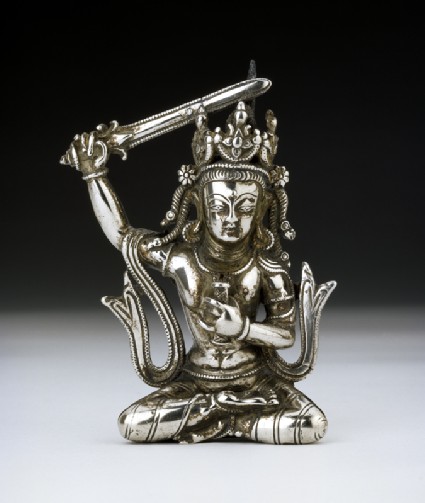Browse: 27 objects
- Reference URL
Actions
Figure of Manjushri, Bodhisattva of Wisdom
-
Details
- Associated place
- Date
- 11th century (1001 - 1100)
- Material and technique
- silver, inlaid with copper, with traces of blue pigment
- Dimensions
- 8.9 x 6 x 2.4 cm max. (height x width x depth)
- Material index
- Technique index
- Object type index
- No. of items
- 1
- Credit line
- Purchased, 1994.
- Accession no.
- EA1994.116
-
Further reading
Heller, Amy, Early Himalayan Art (Oxford: Ashmolean Museum, 2008), no. 37 on p. 116, p. 30, illus. p. 117
Location
Objects are sometimes moved to a different location. Our object location data is usually updated on a monthly basis. Contact the Jameel Study Centre if you are planning to visit the museum to see a particular object on display, or would like to arrange an appointment to see an object in our reserve collections.
Galleries
Publications online
-

Early Himalayan Art
Manjusri, the Bodhisattva of Wisdom, sits wielding the sword which cuts through spiritual ignorance, while holding a book of scripture in his other hand [1]. This image is a work of considerable power, due to its extreme refinement of detail and remarkable workmanship in silver, which are all the more impressive in view of its relatively small scale.
In its aesthetic, the image derives from Kashmiri prototypes of seated Buddha and Bodhisattva figures, as developed in western Tibet in the tenth to eleventh century [2]. The body has the typical Kashmiri athletic torso with developed pectoral muscles (and application of copper inlay for the nipples) and well-defined abdomen, as well as the long head with a broad forehead and narrow jaw, elongated almond eyes, a tiny mouth, and thin lips [3]. If the artist had been Kashmiri, however, the facial type would probably have been more oval in form and the cheeks and chin more rounded. The crown with three crescents containing jewels and the lateral florets and sash are also typical of the Tibetan version of the Kashmiri style. Such motifs were adopted in western Tibet, where teams of Kashmiri artists had migrated during the late tenth and eleventh centuries. Western Tibetan sculptors also began to produce images inspired by the contemporary schools of Kashmir, sometimes in collaboration with resident Kashmiri artists. The thin sashes which curve upwards also reflect the stylistic influences of Pala India, which had reached Western Tibet through Buddhist teachers from eastern India such as Atisa, and the Nepalese artists whose work in western Tibet is documented from c. 1000 AD.
The rear of the statue is fully finished. The back of the head has a tang at the nape of neck, and a scarf draped to the mid-back and shoulders, with a very fine pure curve to the scarf. There is a repetition of the beading on the edges of the sash-ends and on the chains worn by the figure. The wrists are encircled by plain bands, although the ankle bands have chains and spherical jewels on top. The right foot is slightly elevated, to reveal the incised circular sacred marks on the sole of the Bodhisattva's foot. His book is decorated with geometric motifs, incised diagonal lines and circles, indicating either a fabric book cover or a carved wooden cover.
The crown, striated hair, and jewellery recall in particular a sculpture of Padmapani now in the Pritzker collection [4]. That image had consecration contents inscribed with Tibetan prayers inserted in a small cavity at the back of the head, a clear sign of Tibetan patronage, although the nationality of the artist remains uncertain. In this Manjusri there are no such consecrations or inscriptions, yet its elegant casting and aesthetic refinement appear to reflect the cosmopolitan cultural milieu of Western Tibet, where panditas and artists from Eastern India, Kashmir, and Nepal were all engaged in the construction of new Buddhist sanctuaries and libraries.
[Footnotes:]
1 Published in Casey Singer, Selection 1994 (Rossi and Rossi Ltd), cat. 7.
2 See the same powerful musculature and sattvaparyanka asana of the seated Manjusri attributed to Kashmir, 9th-10th century, in the Berti Aschmann Foundation, Rietberg Museum (Uhlig, The Path to Enlightenment, pl. 60), and the Manjusri of the Los Angeles County Museum of Art, attributed to Ladakh or Western Tibet, eleventh century (Pal, Art of Tibet, no. S4). M.-T. de Mallmann stipulates that this asana is specific to certain forms of Manjusri (de Mallmann, Introduction a l'iconographie du tantrisme bouddhique, p. 9).
3 See the Vajrasphota in the Nyingjei Lam collection for similar treatment of the nipples: Weldon and Casey Singer, The Sculptural Heritage of Tibet, pl. 14; and Pal, Himalayas: An Aesthetic Adventure, pl. 63, Buddha Amoghasiddhi, now in the Metropolitan Museum of Art.
4 See Heller, Tibetan Art, pl. 34, also illus. in Pal, op. cit., pl. 85; the large hands and facial features of the Bodhisattva now in the Asia Society collection (ibid., pl. 86) also bear a strong resemblance to the face of the Ashmolean Manjusri.
© 2013 University of Oxford - Ashmolean Museum








